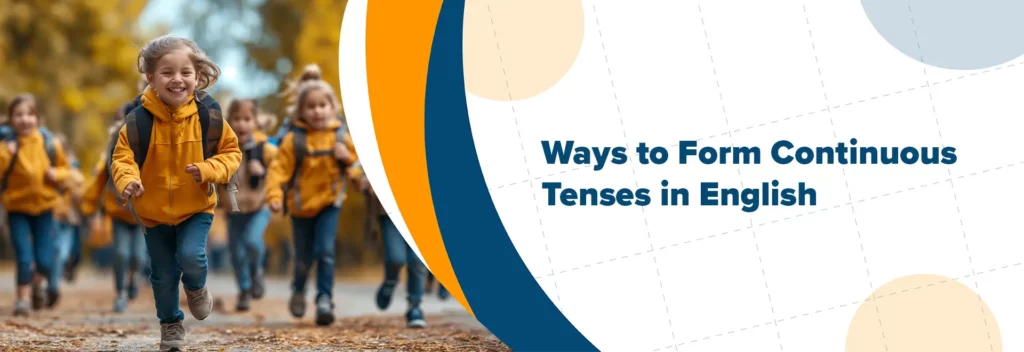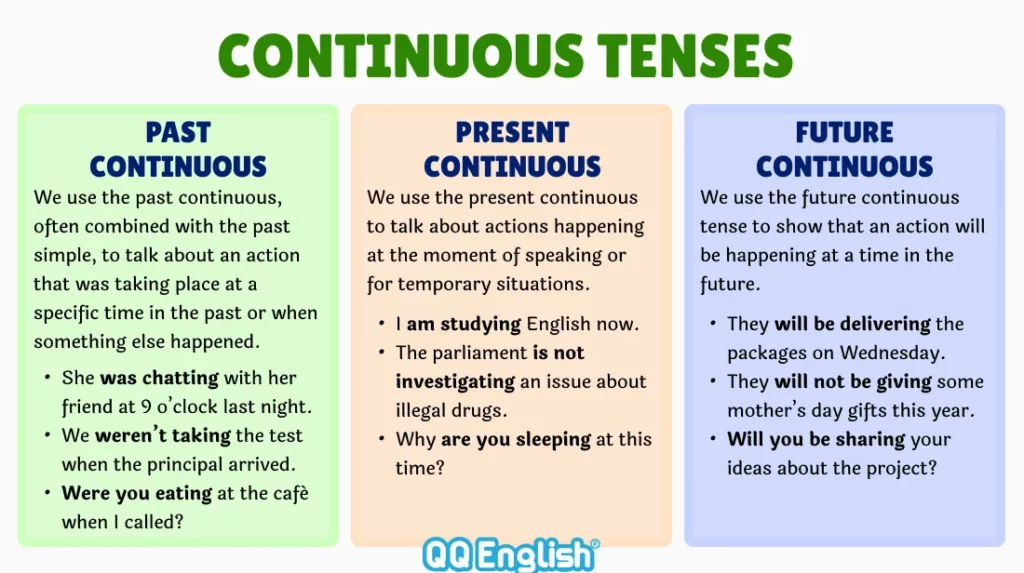
Continuous Tenses in English: 3 Easy Ways to Form Them with Examples
The English language is tricky at times because of the many aspects it holds. The tenses in English are part of these aspects that play a very important role especially to language learners. These English tenses are not limited to present, past, and future, but they have more specific tenses within them.
Did you know that aside from them, there are also continuous tenses in English? Yes, you read it right!
What do you know about continuous tenses in English?
What are the continuous tenses in English?
In English grammar, continuous tenses are used to describe actions or events that are continuing. These tenses indicate actions that are in progress at a particular time of speaking.
There are three continuous tenses in English: Present continuous, past continuous, and future continuous tenses. The continuous tenses in English describe a temporary action.

Present continuous tense
The present continuous tense is used to describe actions or events that are happening at the present time of speaking.
Structure: be verbs (is/am/are) + verb-ing form (present participle)
Examples:
- I am studying English now.
- The children are playing soccer in the football field.
- Why are you sleeping at this time?
- He is presenting his report at this moment.
Note: Not all present continuous tenses in English need a time marker to understand that they are present continuous tenses.
Past continuous tense
The past continuous tense describes temporary actions that were done in the past. It started at a particular short time but ended soon as well.
Structure: be verbs (was/were) + verb-ing form (present participle)
Examples:
- My parents were attending a wedding at this time yesterday.
- She was chatting with her best friend at 9 o’clock last night.
- I was reading a book when my sister entered the room.
Notice that the actions in the past are specific because of the time marker and also because of another action that happened at the same time.
Future continuous tense
The future continuous tense talks about anticipated actions that will likely to happen at a particular time in the future.
Structure: will be + verb-ing form (present participle)
Examples:
- The manager will be attending a conference in Tokyo this weekend.
- Our teacher will be checking our homework tomorrow.
- They will be delivering the packages on Wednesday.
- He will be discussing the issue in today’s meeting.
Notice that the actions are understood to be happening in the future, although some are intended for the soonest time.
The continuous tenses in English are easily noticed in sentences. You just have to take note and remember how they are formed through their structure.
Forming negative continuous tenses in English
It is not difficult to form negative continuous tenses. The word “not” is always present in these sentences.
Structures:
Present continuous: am/is/are + not + present participle
Past continuous: was/were + not + present participle
Future continuous: will + not + be + present participle
Examples:
The parliament is not investigating an issue about illegal drugs.
We were not taking the test when the principal arrived in the classroom.
They will not be giving some mother’s day gifts this year.
Forming questions with continuous tenses
In forming questions with continuous tenses in English, the structure is different from the usual sentence. The “be-verbs” are put in the first part of the sentence with the pattern: be-verb / will + subject + present participle.
However, in negative questions, the word “not” is inserted after the subject.
Examples:
Are you standing on the floor?
Is she coming with us to the museum?
Will you be sharing your ideas about the project?
Are they not taking pictures of the beautiful scenery?
Were you eating at the café when I called?

Key insights to remember about continuous tenses in English
- The continuous tenses in English emphasize the duration and nature of the actions or events.
- These tenses describe activities that are ongoing or in progress.
- Continuous tenses in English are useful for describing temporary events that are happening at a particular time.
- By using time frames in sentences, it is easy to identify which continuous tense is being described.
- The continuous tense always uses the present participle of the main verb.
- The “verb-ing” form in continuous tenses is not a gerund.
“Verb-ing as gerund” vs “verb-ing” in continuous tense
It is often a misconception, especially for English language learners, that verbs in the “-ing” form always function as a verb in sentences. However, for those who are familiar with gerunds or verbs in the “-ing” form that function as nouns, they sometimes confuse their usage in sentences.
Gerunds are verbs that function as nouns or subjects in sentences. They are verbs that end in “-ing,” but their main role in sentences is not to perform the action. They are not in the continuous tenses. They take any tense, as long as they are used appropriately in sentences.
“Verb-ing” forms are present participles of the main verb. They take the continuous tenses in English, which means they function as verbs that perform the action in the sentence.
Take the examples below.
She is swimming in the pool.
Swimming in the pool is her favorite leisure activity.
The word “swimming” functions here differently. In the first sentence, the word “swimming” functions as a verb and in the present continuous tense. It answers the question, “What is she doing?” The answer is “swimming in the pool.”
In the second sentence, it functions as a gerund. It answers the question “What is her favorite leisure activity?” The answer is “swimming in the pool.”
Take note that gerunds (verb-ing) are the ones being talked about in the sentence, whilst” verb-ing” in continuous tenses in English are the ones doing the action in the sentence.
Are you ready to practice your knowledge of the continuous tenses in English?
Test Yourself!
Identify whether the underlined word used in the following sentences is a gerund or a verb in a continuous tense.
_______________ 1. Who was chatting when the administrator came here?
_______________ 2. We were not joking when I said I’d leave the team.
_______________ 3. They have been interested in painting.
_______________ 4. Many teachers say teaching is their passion.
_______________ 5. It’s a great idea to include travelling in your goals.
_______________ 6. The government is distributing relief goods to the victims of typhoon.
_______________ 7. Speaking in public is one of my greatest weaknesses.
_______________ 8. The employees are complaining about their low compensation.
_______________ 9. Am I not stating a fact about his wrongdoings?
_______________ 10. They are not following the rules of the company so they were dismissed.
Good job! Check your answers here.




